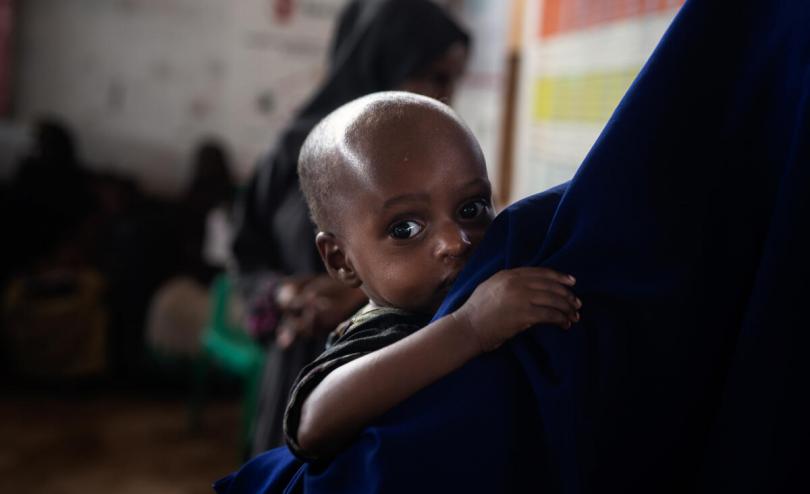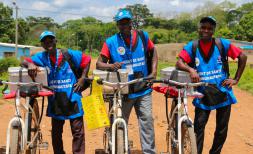2023 IN REVIEW - Nearly 16,000 children a day plunged into hunger in top 10 worsening food crises

Photo: Fredrik Lerneryd / Save the Children
LONDON/GENEVA, 21 Dec 2023 – About six million children were pushed into hunger in the top 10 countries that faced worsening food crises this year, which was a 32% increase compared to 2022, according to a new analysis by Save the Children.
Since January, 5.8 million children – or about 16,000 children a day – have entered chronic levels of hunger in Sudan, Somalia, Burundi, Djibouti, Gambia, Haiti, Lebanon, Liberia, Senegal and Malawi this year, based on the Integrated Food Security Classification (IPC) data. This means a combined 24 million children are now going hungry in those countries.
Sudan experienced the most significant deterioration, with two in every five children in the country not knowing where their next meal will come from.
The situation in Sudan has spiralled out of control following the outbreak of violence in April, which pushed four million children into crisis levels of hunger or worse this year, marking a staggering 74% increase from 2022. The number of children teetering on the brink of starvation in Sudan has doubled to 2.9 million from 1.4 million in last year.
Somalia saw the second-worst deterioration of hunger in 2023, with an additional 500,000 children facing hunger this year compared to last, bringing the total number of children going hungry to 3.5 million.
The IPC does not monitor the hunger emergency in the occupied Palestinian territory so it was not included in Save the Children’s analysis.
Under the IPC scale, Phase 3 is a crisis, Phase 4 is an emergency, and Phase 5 is used for when the situation is reaching famine-like conditions — the worst scenario categorised by starvation, death, and extremely critical acute malnutrition levels.
Nana Ndeda, Head of Advocacy and Policy for Hunger at Save the Children, said:
“This year, we saw global hunger skyrocket in multiple countries around the world, including Sudan which faced a shocking four million more children going hungry. Hunger is not a lost cause. Huge progress has been made in recent decades, but if conflicts, economic instability and the climate crisis worsen, so will hunger. If we want to put an end to global hunger, we need to address all the root causes. We can’t keep sweeping it under the rug.”
The Democratic Republic of the Congo (DRC) remained the world’s biggest child hunger crisis in 2023 despite a slight reduction in the number of children facing crisis levels of hunger in the country. This year, about 13.5 million children were acutely food insecure.
Overall, there was some progress in alleviating some of the world's largest food crises affecting children, where the situation remained relatively stable as measured by the percentage of children in IPC Phase 3 and above.
Save the Children is calling on world leaders to address the root causes of acute food and nutrition insecurity. Only by putting an end to global conflict, by tackling the climate crisis and global inequality, and by building more resilient health, nutrition, and protection systems that are less vulnerable to shocks like COVID-19, conflicts, and the climate crisis, will we be able to ensure the same warnings are not ringing out again in the coming years.
Save the Children is also calling for greater collaboration between governments, development and humanitarian organisations, climate groups, and the private sector. Children and other community members need to be able to have their say in these discussions. No sector or intervention alone can respond to the many causes and vulnerabilities leading to food and nutrition insecurity, but combined, the impact will be more effective, efficient and at scale.
ENDS
Notes to Editor
- The data covers countries with a comparable IPC analysis in 2022 and 2023 and compares the highest numbers of children in IPC3+ each year. The analysis looks at children in IPC Phase 3 and above at the worst point for the country in 2023 in 2022.
- As a result, countries with no new analysis in 2023 such as Ukraine, Syria and Myanmar were excluded as were those with non-comparable data. In the case of Pakistan, Bangladesh and Nigeria this was due to a significant increase in the population analysed. In the case of others such as Yemen, the methodology changed.
- Child shares are estimated based on UN data.
Below is a list of the 10 countries with comparable analysis coverage where there was an increase in the number and share of the population facing crisis levels of hunger or worse.
- Sudan
- Somalia
- Burundi
- Djibouti
- Gambia
- Haiti
- Lebanon
- Liberia
- Senegal
- Malawi
*******************************************************************************************************************
For further enquiries please contact:
- Samantha Halyk, Senior Global Media Manager based in London Samantha.halyk@savethechildren.org
- Emily Wight, Global Media Manager based in London, emily.wight@savethechildren.org
- Save the Children’s Global Media Unit GMU@savethechildren.org
Our media out of hours (BST) contact is media@savethechildren.org.uk / +44(0)7831 650409
Please also check our Twitter account @Save_GlobalNews for news alerts, quotes, statements and location Vlogs.




